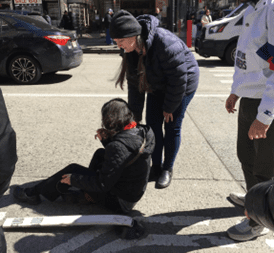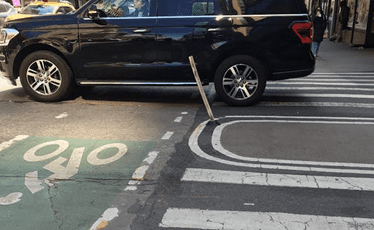New York City, like other cities, is increasingly pushing for traffic changes that accommodate for more pedestrians and cyclists. What most don’t realize is that these changes are being made so cheaply, that they leave the streets more of a hazard for pedestrians than before.

We’ve all seen it, those yellow or white posts that mark the bike lanes or cross walks and stand on each city street. They’re called channelizer posts, pylons, traffic beams, or stanchions — but regardless of what you call them, you’ve seen them on New York City’s streets.
These “channelizer posts” are intended to direct traffic and make the streets safer for bicyclists and pedestrians, at least temporarily. They are all made of cheap plastic, forcefully inserted into a holder in the ground, and are made to “bounce back” when struck by a vehicle.
These channelizer posts are creating hazards for the millions of people that walk and bike on New York city’s streets. We will explore some of the injury these have caused, and how their use as a traffic guide is an insult to New Yorkers.
Defective road accident attorneys in New York are familiar with the laws pertaining to road conditions and can help you recover if injured.
Read on to learn more about road defect accident attorneys in New York.
Preposterous Plastic — A Challenging Environment to Recover for Injuries
The history of these channelizer posts is one filled with complaint, injury, and built on the foundation of sub-par safety standards in the world’s largest free market. Since the issues to traffic or public safety caused by these channelizer posts aren’t enough to spark change, one must look to the unfavorable legal environment that makes suing the city regarding to these posts extremely difficult.
New York City Administrative Code 7-201 (1) states that “No civil action shall be maintained against the city for damage to property or injury to person or death sustained [in NYC] unless it appears that written notice of the defective, unsafe, dangerous or obstructed condition was actually given to the commissioner of transportation… and there was a failure or neglect within fifteen days after the receipt of such notice to repair or remove the defect.”
Essentially, this means that for an injury claim to be made against the city — there must have been a prior written notice of the defect and 15 days where the city failed to fix the defect before injury occurred. Due to the nature of these channelizer posts, and the speed at which they become road hazards, giving prior written notice becomes nearly impossible.

As you can see in this picture, these channelizers break easily and can blend right in with road markings. There have been several instances of pedestrians becoming injured by these pieces of plastic, and a history of the city turning down their claims.
A History of Legal Filings and an Ending in Sight
Several injuries have resulted from poorly maintained channelizer posts, and subsequently many attempts to recover for these injuries have ensued. As we mentioned before, suing the city itself is a difficult task due to Article 7-201, so lawyers need to be creative when acting on behalf of their clients who’ve been injured by these posts. Several cases have been made which pave the way for legal discourse about these posts and get us closer to an ultimate resolution.
Road Defect Accident Attorney Case
One important case is Biberman vs The City of New York and Pexco LLC (2) which is currently being handled by the Supreme Court of the State of New York. Like many others, Caren Bieberman was injured because of a faulty channelizer post in New York City. In her suit against Plexco (manufacturer) she alleges that “at the time of the original sale, the [channelizer post] involved here was defective” insofar as “it fail[ed] to bounce back to its normal vertical position when struck.”
Plexco, which manufacturers the various channelizer posts used throughout New York, moved to dismiss the case against it on the grounds that its channelizer posts are subject to various review, maintenance, and replacement as required by Department of Transportation (DOT) and others. Realizing that the posts at the subject of the lawsuit were in fact manufactured by Plexco, and certainly the traffic hazard responsible for Ms. Bieberman’s injuries, the court dismissed Plexco’s request for summary judgment.

While originally designed to “bounce back” and hold position after several impacts, these posts are consistently bent and made to be hazards on the streets of New York City. It is thanks to Ms. Bieberman’s case and others like it that we now have the legal footing to hold the manufacturers of these posts responsible for the injuries and traffic issues they cause.
Contact the Sidewalk Accident Lawyers in New York at Leav & Steinberg LLC
Clearly, a higher quality solution is needed to direct the volume of vehicles and pedestrians using New York’s streets each day. Until we have a more permanent solution than these channelizer posts, it is likely that injuries will continue to occur.
As you have seen, recovering for these injuries is not always simple. If you’ve been injured by channelizer posts or other road defects, you would be well-advised to consult with a road defect attorney that’s familiar with NYC laws and experienced in helping clients recover.
The team of sidewalk accident lawyers at Leav & Steinberg have years of experience in representing clients injured on New York City’s streets and have recovered millions as a result of road defects similar to these channelizer posts.
Contact the defective road accident attorneys in New York at Leav & Steinberg for a free-consultation on your case, and speak with a partner familiar with the laws pertaining to road defects, that will fight to ensure you recover the maximum amount available based on your case.
Resources:









